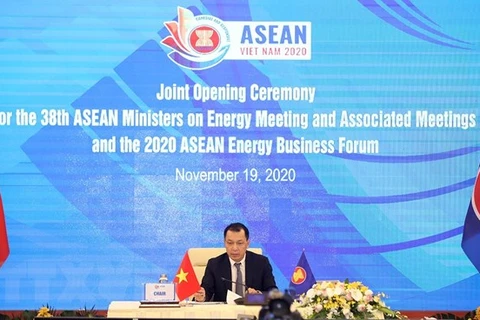 Nguyen Duc Hien, vice chairman of the Party Central Committee’s Economic Commission, delivers a speech at the seminar on International Financing for Independent Power Projects (IPPs) on November 24 in Hanoi. (Photo: VietnamPlus)
Nguyen Duc Hien, vice chairman of the Party Central Committee’s Economic Commission, delivers a speech at the seminar on International Financing for Independent Power Projects (IPPs) on November 24 in Hanoi. (Photo: VietnamPlus) Hanoi (VNA) – Vietnam will need 150 billion USD to invest in power generation projects in the next 10 years, equal to half of the country’s current gross domestic product (GDP), which raises demand for international financing.
Dang Huy Dong, head of the Institute for Planning and Development, provided this estimate and emphasised given the current size of the domestic capital market, for at least the next five years, the economy cannot meet the capital requirements for the development of the power sector.
Dong made this statement at the seminar “International Financing for Independent Power Projects (IPPs)” on November 24 in Hanoi.
Since 2015, Vietnam has become a low-middle-income country which reduces its access to concessional sources of finance from development partners such as Official Development Assistance (ODA).
“Therefore, capital can only be mobilised from international financial institutions,” Dong said.
The international capital market is very large with tens of thousands of billions of USD, more than enough to satisfy Vietnam’s capital need. However, Dong said such capital flows are highly competitive, running on supply-demand principles and certain standards, which requires borrowers to comply.
“Capital, like other commodities, is traded at different prices. The cost of capital is mainly determined by the risk of the investment; high risk, high cost requires high return and vice versa,” Dong said.
In February this year, the Politburo issued Resolution No. 55-NQ/TW on Vietnam’s strategic orientations for energy development through 2030 and with an outlook to 2045. Under the resolution, total installed capacity of power sources will be raised to about 125-130 GW and the power output to 550-600 billion kWh by 2030. Total final energy consumption will touch 105-115 million TOE by 2030 and 160-190 million TOE by 2045.
The resolution lays out the task of researching and completing the funding mechanism for the power sector. It encourages all economic sectors, particularly the private sector, to engage in developing the power industry and allows private investors to invest and use power infrastructure and services, including the national power transmission network, with national defence and security taken into account.
Data from the Party Central Committee’s Economic Commission shows that IPPs (Independent Power Producers), which have been operational, reached combined capacity of 16,400 MW, accounting for 28.3 percent of the total designed capacity of the national grid.
Nguyen Duc Hien, vice chairman of the commission, said attracting private and foreign direct investment in the power industry as well as in IPPs faces many difficulties while funding from the State budget and ODA sources is limited.
Hien said loans from domestic credit institutions are restrained because energy projects require large capital sources but regulations of the law on credit organizations hampers lending to this sector. In addition, foreign direct investment (FDI) in the power sector also has some problems in the field of foreign exchange management such as foreign currency conversion, money transfer and exchange rate risk.
“Finding and accessing international financial and credit institutions for power projects, especially independent projects, is a necessary requirement,” Hien said.
With a total investment of nearly 13-15 billion USD per year, the size of the Vietnamese market is attractive enough for investors, Hien said but noted Vietnam needed to attach importance to the role of the national credit rating as it will help the Government, financial institutions and businesses reduce the cost of raising capital in international markets.
International capital flows only move to countries that meet three criteria, including large market size; profitability at an attractive level; and low risk.
Hien said the country should standardise the regulation on power purchase agreements (PPA) in accordance to international practices because this is the most important factor that determines the cost of capital. The regulation also should have a reasonable risk-sharing and allocating mechanism, avoiding leaving all risks to investors.
Besides, the electricity pricing mechanism also needs to be appealing enough to investors, ensuring essential profitability to attract international capital flows, he added./.























